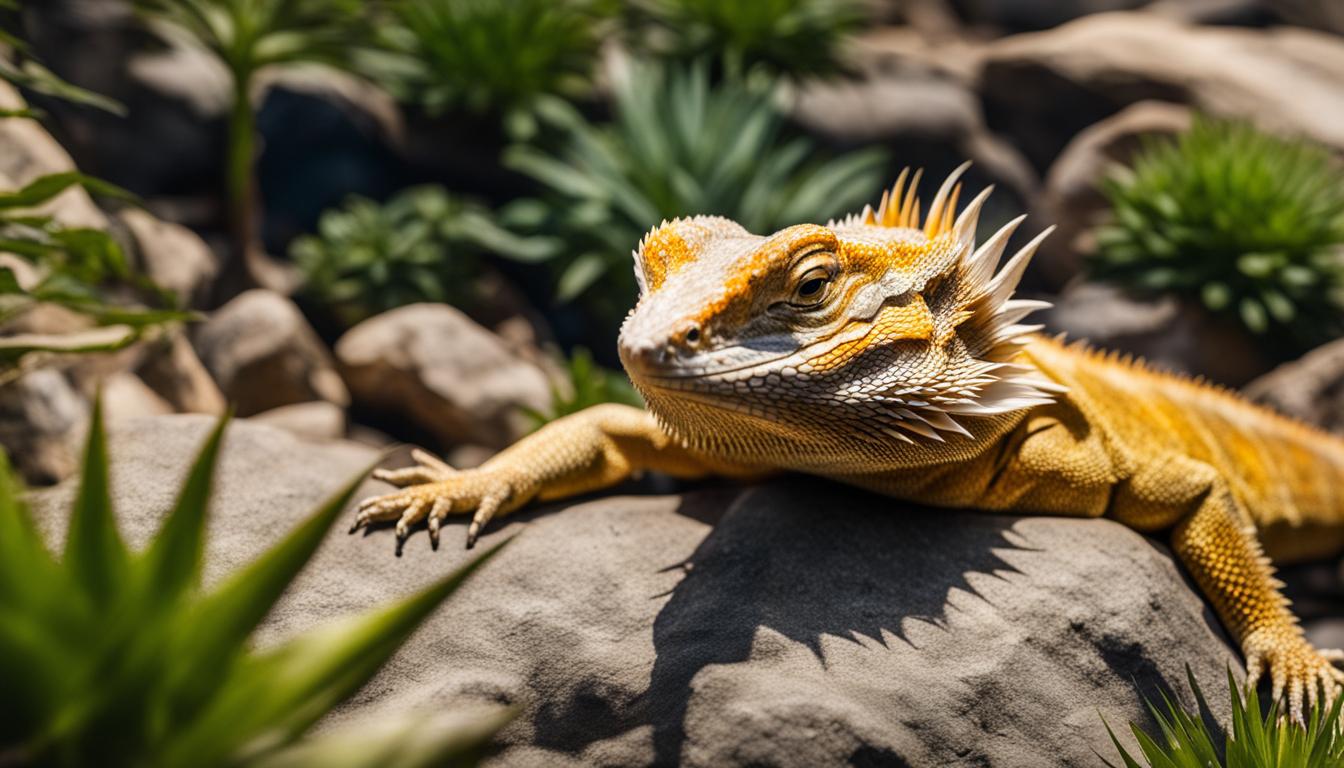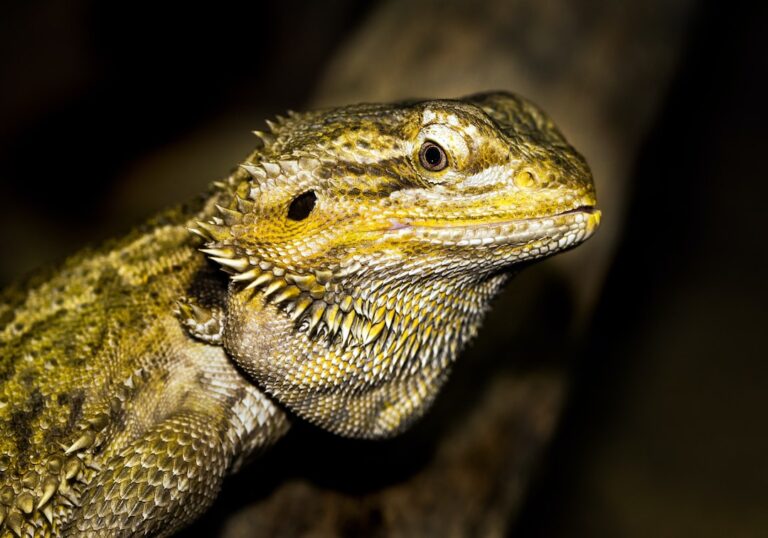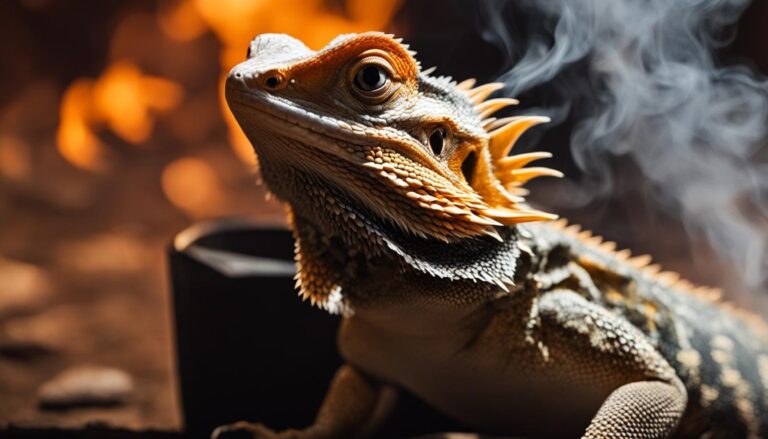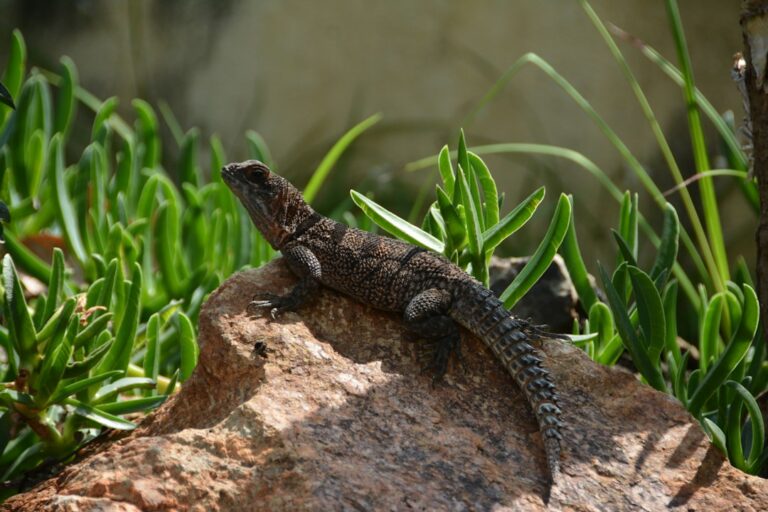Are Bearded Dragons Lazy?
Bearded dragons are fascinating creatures known for their active and curious nature. However, there may be times when they appear lazy or lethargic, causing concern among their owners. In this article, we will delve into the behavior of bearded dragons to determine whether they are naturally lazy or if there are underlying factors that contribute to their perceived laziness. We will also explore the importance of providing optimal living conditions, maintaining a balanced diet, preventing dehydration, understanding brumation, addressing parasite infestations, and promoting enrichment and interaction to ensure the well-being and energy levels of these amazing reptiles.
Table of Contents
Key Takeaways:
- Bearded dragons may exhibit behaviors that appear lazy or lethargic, but it is important to determine if there are underlying health issues or natural causes.
- Providing optimal living conditions, such as temperature regulation and full-spectrum lighting, is vital for maintaining bearded dragon energy levels.
- A balanced diet, proper hydration, and regular veterinary care can help prevent health issues that may contribute to a bearded dragon’s lethargy.
- Understanding brumation, the reptilian form of hibernation, is crucial in interpreting changes in bearded dragon activity levels.
- Parasites can impact a bearded dragon’s energy and health, so preventative measures and prompt treatment are essential.
- Enriching the bearded dragon’s environment with toys, climbing structures, and interaction can stimulate activity and engagement.
- Handling bearded dragons safely and regularly interacting with them can boost their energy levels and overall well-being.
Understanding Bearded Dragon Behavior
Understanding the behavior of bearded dragons is essential for any owner. It allows us to differentiate between normal behavior and behavior that may indicate an underlying health issue. In this section, we will delve into the intricacies of bearded dragon behavior, addressing topics such as laziness, lethargy, and activity levels.
Defining Laziness vs Lethargy in Bearded Dragons
When discussing bearded dragon behavior, it’s important to distinguish between laziness and lethargy. Laziness refers to a bearded dragon’s occasional inclination to rest and conserve energy. It is a normal part of their behavior and should not be cause for concern. On the other hand, lethargy is a state of extreme fatigue or weakness that persists for an extended period. Lethargy may signal an underlying health issue and requires attention from a veterinarian.
Normal Activity Levels in Bearded Dragons
Bearded dragons are generally active and curious creatures. Their normal activity levels can vary depending on factors such as age, time of day, and environmental conditions. Younger bearded dragons are usually more active and playful, while older ones tend to exhibit more relaxed behavior. By observing their daily patterns and interactions, we can gain a better understanding of their individual activity levels.
The Impact of Brumation on Activity
Brumation is a natural phenomenon in which bearded dragons enter a state of reduced activity, similar to hibernation. It typically occurs during the winter months and can last for several weeks or even months. During brumation, bearded dragons’ metabolism slows down, causing them to become less active and seek out a cozy spot to rest. It is important to note that brumation is a normal part of their annual cycle and should not be mistaken for lethargy or a health issue.
Understanding bearded dragon behavior is key to providing them with the appropriate care and ensuring their well-being. By distinguishing between laziness and lethargy, observing their normal activity levels, and recognizing the impact of brumation, we can better interpret their behavior and respond effectively. In the next section, we will explore the various factors that can influence bearded dragon energy levels.
Factors Influencing Bearded Dragon Energy Levels
Understanding the factors that influence bearded dragon energy levels is essential for providing optimal care and ensuring their overall health and well-being. Several key factors play a role in determining the energy levels of these fascinating reptiles. By taking these factors into account, we can identify potential causes of low energy levels and take appropriate action to address them.
Environmental Conditions:
The environment in which a bearded dragon lives can significantly impact its energy levels. Ensure that the enclosure provides adequate space for the dragon to move and explore. Additionally, maintain the appropriate temperature gradient and lighting to support their physiological needs. Bearded dragons require a basking spot with temperatures between 95-105°F (35-40°C) and a cooler side of the enclosure around 80°F (27°C) to regulate their body temperature effectively. A lack of suitable environmental conditions can lead to decreased energy levels.
Diet and Nutrition:
Proper nutrition is crucial for maintaining high energy levels in bearded dragons. Their diet should consist of a variety of live prey, such as crickets, roaches, and mealworms, as well as a selection of fresh vegetables and occasional fruits. A well-balanced diet ensures that bearded dragons receive the necessary nutrients, vitamins, and minerals to support energy production and overall vitality. Consider consulting with a reptile veterinarian or herpetologist to develop a suitable diet plan for your bearded dragon.
Hydration:
Adequate hydration is essential for the overall health and energy levels of bearded dragons. Ensure that your dragon has access to fresh, clean water at all times. Providing water in a shallow dish or utilizing a drip system can help prevent dehydration. Additionally, consider misting the enclosure to increase humidity levels and assist with hydration.
Overall Health:
Good health is a major contributing factor to the energy levels of bearded dragons. Regular veterinary check-ups are important to monitor their overall well-being and address any potential health issues promptly. Be aware of common health concerns in bearded dragons, such as respiratory infections, digestive problems, and parasites, as these can significantly impact energy levels. Proper husbandry practices, including routine cleaning of the enclosure and maintaining optimal living conditions, can help prevent health issues and support high energy levels.
By taking into account these factors, we can create an environment that supports the natural energy levels of bearded dragons. Providing suitable living conditions, a well-balanced diet, adequate hydration, and routine veterinary care will help ensure that your bearded dragon thrives with optimal energy and vitality.
Identifying Signs of Health Issues
Recognizing signs of health issues in bearded dragons is crucial for their well-being. It is important to stay vigilant and pay attention to any changes in their behavior or physical condition. One common warning sign to watch out for is lethargy, which can indicate underlying health problems.
Recognizing Lethargy as a Warning Sign
Lethargy refers to a state of extreme tiredness or lack of energy. While bearded dragons may occasionally exhibit periods of calmness or slower activity, persistent lethargy should be taken seriously as it can be a red flag for potential health issues. If your bearded dragon is consistently inactive, unresponsive, or spends most of its time sleeping, it is important to investigate further.
Closely observe their eating habits, as decreased appetite and weight loss can accompany lethargy. Changes in hydration and bowel movements should also be monitored, as they can indicate underlying health concerns.
Common Health Concerns in Bearded Dragons
Bearded dragons can experience a range of health concerns that may contribute to lethargy. Some common issues include:
- Respiratory issues: Respiratory infections, such as pneumonia, can cause breathing difficulties and lethargy in bearded dragons.
- Digestive issues: Problems with digestion, such as impaction or gastrointestinal tract infections, can impact a bearded dragon’s energy levels.
- Parasites: Infestations of internal or external parasites, such as mites or worms, can cause discomfort and drain your bearded dragon’s energy.
It is essential to be aware of these common health concerns and their potential impact on your bearded dragon’s well-being.
When to Seek Veterinary Care
If you notice persistent lethargy or any other concerning symptoms in your bearded dragon, it is important to consult a veterinarian who specializes in reptile care. They can conduct a thorough examination and diagnostic tests to determine the underlying cause of the lethargy and recommend appropriate treatment.
Remember, early intervention and veterinary care play a vital role in ensuring the health and well-being of your bearded dragon.
Are Bearded Dragons Lazy by Nature?
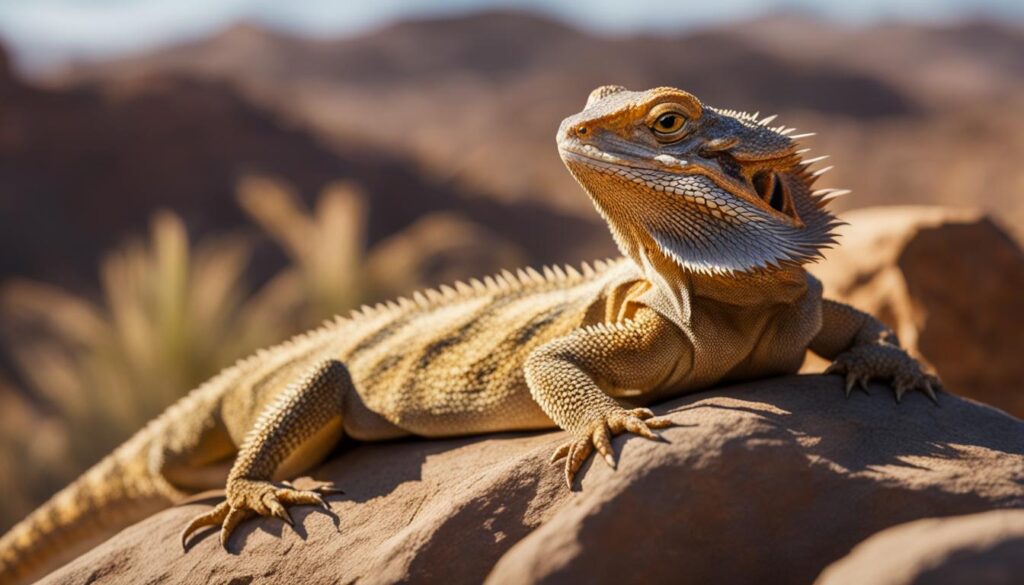
When it comes to bearded dragons, their behavior can sometimes be mistaken for laziness. But is this laziness a natural characteristic or a sign of an underlying issue? To determine the answer, let’s explore the natural characteristics and behavior of bearded dragons.
Bearded dragons are known to be active and curious creatures, constantly exploring their surroundings. However, they also have a more relaxed side, often enjoying basking in the warmth and observing their surroundings from a comfortable spot.
It’s important to note that bearded dragons are ectothermic reptiles, meaning their body temperature is regulated by their environment. As a result, their activity levels can vary based on temperature, time of day, and even their own preferences.
While bearded dragons may appear lazy at times, it’s essential to understand the difference between inherent laziness and abnormal behavior. If a bearded dragon suddenly becomes consistently lethargic, shows a lack of appetite, or displays other concerning symptoms, it could indicate an underlying health issue that requires attention.
In conclusion, bearded dragons are not necessarily lazy by nature. Their behavior is a combination of their natural characteristics as reptiles and their response to their environment. By being attentive to their overall well-being and monitoring any significant changes in behavior, you can ensure your bearded dragon’s health and happiness.
Optimal Living Conditions for Bearded Dragons
When it comes to keeping bearded dragons healthy and active, providing optimal living conditions is essential. This includes maintaining the right temperature, ensuring proper lighting, and creating a stimulating environment that encourages their natural behavior. Let’s explore each of these factors in detail.
Temperature and its Effects on Bearded Dragon Behavior
Bearded dragons are ectothermic, meaning they rely on external heat sources to regulate their body temperature. To create a comfortable and balanced environment for your dragon, it’s crucial to provide a temperature gradient within their enclosure. This allows them to thermoregulate by moving between warmer and cooler areas as needed.
The optimal temperature range for bearded dragons is between 95°F (35°C) and 105°F (40°C) in the basking area and around 80°F (27°C) in the cooler area. Maintaining these temperatures is vital for digestion, metabolism, and overall physical and mental well-being.
Proper temperature regulation is closely linked to bearded dragon behavior. When exposed to the right temperature, they are more likely to exhibit natural behaviors such as hunting, exploring, basking, and increased activity levels. Conversely, if the temperatures are too low or too high, it can lead to lethargy, decreased appetite, and even health issues.
The Role of Full-Spectrum Lighting
In addition to temperature, bearded dragons also require adequate lighting, particularly full-spectrum lighting, to thrive. Full-spectrum lighting provides a broad range of wavelengths, including ultraviolet (UV) A and B, which are crucial for the synthesis of vitamin D3 and the absorption of calcium.
UVB lighting is essential for the production of vitamin D3, which is necessary for healthy bone growth and development. Without sufficient UVB exposure, bearded dragons can suffer from metabolic bone disease and other related health problems.
When choosing a UVB light fixture for your dragon’s enclosure, opt for one specifically made for reptiles. Position the light at an appropriate distance from the basking spot to ensure they are receiving the right amount of UVB exposure without being too close or too far away.
Creating a Stimulating Environment
Bearded dragons are curious creatures that thrive in a stimulating environment. Providing them with enriching opportunities promotes their physical and mental well-being, leading to increased activity levels.
Here are some ways to create a stimulating environment for your bearded dragon:
– Incorporate various climbing structures, branches, and basking spots to encourage natural behavior and activity.
– Add hiding spots, such as caves or hollow logs, to fulfill their need for security and privacy.
– Provide a variety of textured surfaces, like rocks or logs, for them to explore and climb on.
– Introduce different toys and puzzles designed specifically for reptiles to keep them mentally stimulated and engaged.
– Arrange their enclosure to mimic a natural habitat, including plants, decorations, and substrate that closely resemble their native environment.
Remember to regularly change and rotate their enrichment items to keep things fresh and exciting for your bearded dragon.
To summarize, optimal living conditions play a pivotal role in the health and activity levels of bearded dragons. Maintaining the right temperature gradient, providing full-spectrum lighting, and creating a stimulating environment are essential for their overall well-being. By prioritizing these factors, you can ensure that your bearded dragon leads a happy and active life.
Diet and Nutrition: Key to Bearded Dragon Vitality
The diet and nutrition of bearded dragons play a fundamental role in their overall vitality and energy levels. A well-balanced and nutritious diet is essential for the optimal health and well-being of these captivating reptiles.
Bearded dragons are omnivorous creatures, meaning they require a combination of live prey and plant-based food to thrive. The ideal diet consists of a variety of insects, such as crickets, mealworms, and dubia roaches, as well as a selection of vegetables and occasional fruits.
Insects: Live prey, like crickets, provide essential protein for bearded dragons. It is important to dust the insects with calcium and vitamin supplements before feeding them to ensure adequate nutrition.
Vegetables: Bearded dragons should be offered a wide range of vegetables, including leafy greens like kale, collard greens, and mustard greens. Other suitable options include bell peppers, squash, and carrots. Vegetables should be chopped or shredded into small pieces for easier consumption.
Fruits: While fruits should be given sparingly due to their higher sugar content, occasional treats like berries, melons, and apples can be offered to provide variety in the diet.
It is important to note that bearded dragons have specific calcium requirements. Calcium is necessary for proper bone development and muscle function. Dusting insects and sprinkling calcium powder on vegetables is crucial for preventing calcium deficiency and related health issues.
Aside from calcium, bearded dragons may also benefit from vitamin supplementation, particularly vitamin D3, which is essential for calcium absorption. Vitamin supplements specifically formulated for reptiles can help ensure that your bearded dragon receives adequate nutrients.
Remember to provide fresh, clean water for your bearded dragon to stay hydrated. However, it’s worth noting that bearded dragons obtain most of their water from their food and do not typically drink water excessively. Keep an eye on their hydration levels and consult a veterinarian if you suspect dehydration.
By providing a well-rounded and nutritionally balanced diet, you can promote the vitality, energy, and overall health of your bearded dragon.
Dangers of Dehydration in Bearded Dragons
Dehydration can have severe consequences for bearded dragons, leading to lethargy and other health issues. It is crucial for owners to be aware of the signs of dehydration and take proactive measures to ensure their dragons are adequately hydrated.
Signs of Dehydration
Recognizing the signs of dehydration is essential for prompt intervention. Look out for the following indicators:
- Loss of skin elasticity
- Wrinkled skin
- Sunken eyes
- Loss of appetite
- Dark or concentrated urine
- Lethargy or reduced activity levels
If your bearded dragon displays any of these signs, it is crucial to take immediate action to rehydrate them.
Methods for Hydrating Your Bearded Dragon
Here are some effective methods to hydrate your bearded dragon:
- Providing a shallow dish of fresh water: Bearded dragons should have access to a shallow dish of fresh water at all times. Ensure the water is clean and changed regularly.
- Misting or spraying: Use a clean spray bottle to mist your dragon’s enclosure with water. This allows them to drink droplets off the surfaces and helps maintain proper hydration.
- Bathing: Gently bathing your bearded dragon in lukewarm water can help them absorb moisture through their ventral skin. Supervise the bath closely to ensure their safety.
- Offering hydrating foods: Bearded dragons can obtain moisture from certain fruits and vegetables, such as cucumbers, melons, and leafy greens. Offer these foods regularly to supplement their hydration.
Remember to monitor your dragon’s water intake and adjust these methods accordingly to ensure they are adequately hydrated.
Importance of Fresh Water Availability
Fresh water availability is crucial for maintaining the health and energy levels of bearded dragons. Ensure there is always clean and fresh water accessible to them, as dehydration can occur rapidly, especially in hot and dry conditions.
Bearded dragons rely on proper hydration to support their overall physiological functions and prevent complications. By proactively addressing dehydration risks, you can help your bearded dragon thrive and maintain optimal health.
Brumation Explained: Dormancy in Bearded Dragons
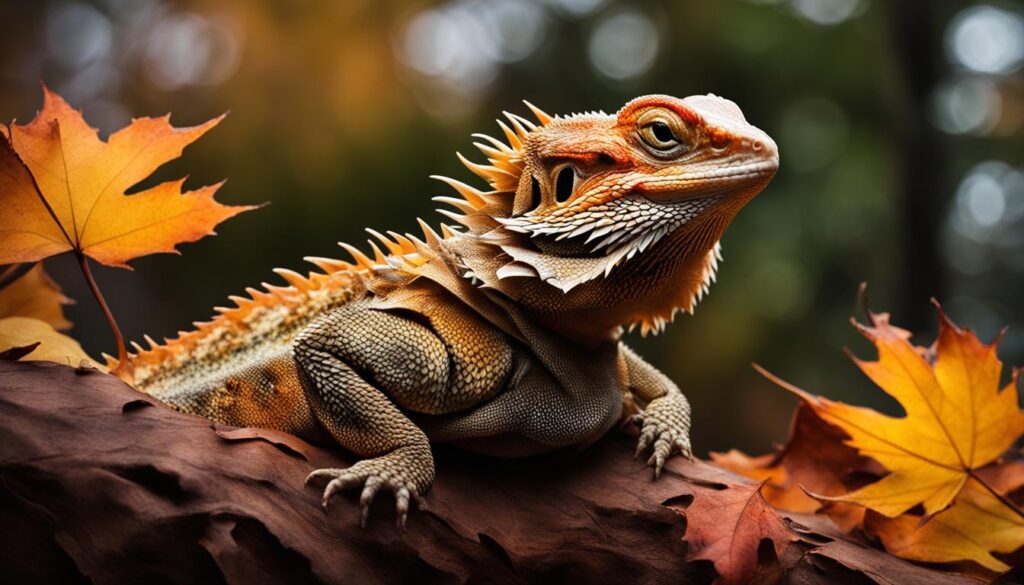
Brumation is a natural period of dormancy that bearded dragons go through. It is important to understand what brumation is, when it typically occurs, and its effects on bearded dragon behavior and activity levels. By familiarizing ourselves with the concept of brumation, we can better determine whether a bearded dragon’s apparent laziness is a natural part of their cycle or a sign of an underlying health issue.
How Parasites Can Affect Bearded Dragon Activity
Parasites can have a significant impact on a bearded dragon’s energy levels and overall health. These unwelcome guests can disrupt the normal functioning of the dragon’s body, leading to decreased activity and lethargy. It is crucial for bearded dragon owners to be aware of the symptoms of parasitic infections, take preventative measures to avoid parasitic problems, and explore treatment options if their dragons become infested with parasites.
Identifying Symptoms of Parasitic Infection
Recognizing the symptoms of parasitic infections is essential for early detection and prompt treatment. Common symptoms include:
- Loss of appetite
- Weight loss
- Lethargy and decreased activity
- Diarrhea or abnormal stool consistency
- Visible presence of worms or other parasites
It is important to monitor your bearded dragon closely for any signs of these symptoms and consult with a veterinarian if you suspect a parasitic infection.
Preventing Parasitic Problems
Prevention is key when it comes to parasitic problems in bearded dragons. By implementing the following measures, you can minimize the risk of your dragon falling victim to parasites:
- Practice good hygiene by keeping the enclosure clean and regularly sanitizing all accessories and equipment.
- Minimize contact with wild or potentially infected animals, including insects and other reptiles.
- Source food from reputable suppliers and ensure all live prey is properly gut-loaded and free from parasites.
- Quarantine new additions to your dragon’s collection to prevent the spread of parasites.
By taking these preventive measures, you can create a safer environment for your bearded dragon, reducing the chances of them encountering parasites.
Treatment Options for Parasite-Infested Bearded Dragons
If your bearded dragon becomes infested with parasites, it is crucial to seek veterinary care for proper diagnosis and treatment. Treatment options for parasite-infested dragons may include:
- Antiparasitic medications prescribed by a veterinarian
- De-worming treatments to eliminate internal parasites
- Topical treatments for external parasites, such as mites or ticks
Always follow the veterinarian’s instructions carefully when administering treatment to ensure the best possible outcome for your bearded dragon.
Enrichment: Encouraging Activity in Bearded Dragons
Enrichment is essential for keeping bearded dragons mentally stimulated and physically active. Providing a stimulating environment can help prevent boredom and promote healthy behaviors in these reptiles. There are various ways to enrich the lives of bearded dragons, ensuring they lead fulfilling and engaging lives.
One effective way to provide enrichment is by incorporating toys into their habitat. Bearded dragons can benefit from interactive toys such as puzzle feeders, balls, and hanging objects. These toys not only provide mental stimulation but also encourage physical activity as the dragons interact with them.
Another enrichment option is the use of tunnels and hiding spots. Bearded dragons are naturally curious creatures and enjoy exploring their surroundings. By providing tunnels and hiding spots in their habitat, you can create opportunities for them to engage in natural behaviors like climbing, crawling, and exploring.
Using climbing structures is another great way to encourage activity in bearded dragons. Create a multi-level habitat with branches, rocks, and platforms for them to climb on. This not only provides physical exercise but also mimics their natural habitat and allows them to exercise their natural instincts.
Enrichment is an essential aspect of caring for bearded dragons. By providing toys, tunnels, and climbing structures, we can create a stimulating environment that encourages activity and engagement, improving their overall well-being and quality of life.
| Type of Enrichment | Description |
|---|---|
| Toys | Interactive toys such as puzzle feeders, balls, and hanging objects. |
| Tunnels and Hiding Spots | Provide opportunities for exploration and mimic their natural habitat. |
| Climbing Structures | Create a multi-level habitat with branches, rocks, and platforms for climbing. |
Handling and Interaction: Boosting Your Dragon’s Energy
Proper handling and interaction play a crucial role in boosting the energy levels of your bearded dragon. By following safe handling practices, you can ensure the well-being of both your dragon and yourself. Additionally, regular interaction with your bearded dragon offers numerous benefits that contribute to their overall health and vitality. Understanding bearded dragon social behavior further enriches your interactions and promotes a more active and engaged pet.
Safe Handling Practices for Bearded Dragons
When handling your bearded dragon, it’s essential to prioritize their safety and comfort. Here are some safe handling practices to follow:
- Gently scoop your bearded dragon from underneath, supporting their body to prevent any undue stress or harm.
- Handle your dragon with clean, dry hands to maintain hygiene and prevent the transfer of harmful bacteria.
- Ensure a calm and quiet environment during handling to minimize stress and anxiety for your dragon.
- Avoid sudden movements or loud noises that may startle or frighten your bearded dragon.
- Never grab or squeeze their tail, as this can cause pain and injury.
The Benefits of Regular Interaction
Regular interaction with your bearded dragon has several benefits that contribute to their energy and overall well-being. These benefits include:
- Bonding: Regular interaction helps to strengthen the bond between you and your bearded dragon, fostering a sense of trust and companionship.
- Physical Activity: Handling your dragon encourages physical activity, keeping them active and preventing lethargy. It also provides necessary exercise for their muscles and promotes healthy body movement.
- Mental Stimulation: Interacting with your bearded dragon stimulates their mind, preventing boredom and promoting overall mental well-being.
- Socialization: Bearded dragons are social creatures, and interaction with their human caregivers helps satisfy their social needs, reducing stress and anxiety.
Understanding Bearded Dragon Social Behavior
Understanding the social behavior of bearded dragons is essential for effective interaction. These reptiles exhibit fascinating behaviors and communication methods. Some key aspects of their social behavior include:
- Head Bobbing: Bearded dragons may head bob as a form of communication, especially during territorial displays or mating rituals.
- Arm Waving: Waving their arms is another communication method used by bearded dragons. It can signify submission or an attempt to establish dominance.
- Eye Contact: Bearded dragons use eye contact to communicate with each other as well as with their human caregivers. It’s important to be mindful of their body language and respect their boundaries.
- Tail Twitching: Tail twitching can signal agitation or excitement. Paying attention to these cues can help you gauge your bearded dragon’s comfort levels during interaction.
By observing and understanding these behaviors, you can better communicate with your bearded dragon and ensure positive and rewarding interactions.
Conclusion
In conclusion, understanding the factors that influence bearded dragon energy levels is crucial for providing optimal care and ensuring their overall health and vitality. By recognizing the signs of health issues, maintaining proper living conditions, providing a balanced diet, preventing dehydration, understanding natural behavior, and promoting enrichment and interaction, we can help our bearded dragons lead active and fulfilling lives. With the right care and attention, bearded dragons can thrive and exhibit the energy levels expected of these amazing reptiles.
FAQ
Are bearded dragons lazy?
Bearded dragons may exhibit behaviors that can be mistaken for laziness or lethargy, but it is important to understand their natural behavior and distinguish between inherent laziness and abnormal behavior.
What factors influence bearded dragon energy levels?
Bearded dragon energy levels can be influenced by environmental conditions, diet, hydration, and overall health.
How can I identify signs of health issues in my bearded dragon?
Lethargy can be a warning sign of underlying health problems in bearded dragons. Common health concerns include respiratory issues, digestive issues, and parasites. It is important to seek veterinary care when necessary.
Are bearded dragons lazy by nature?
Bearded dragons are known for their active and curious nature, but they may exhibit lazy behavior at times. It is important to determine if their laziness is part of their natural cycle or indicative of an underlying health issue.
What are the optimal living conditions for bearded dragons?
Optimal living conditions for bearded dragons include temperature regulation and providing full-spectrum lighting. Creating a stimulating environment with toys, tunnels, and climbing structures is also important.
What is the role of diet and nutrition in bearded dragon vitality?
A balanced diet of live prey, vegetables, and occasional fruits, along with supplements like calcium and vitamins, is essential for maintaining a bearded dragon’s vitality and energy levels.
How can I prevent dehydration in my bearded dragon?
Signs of dehydration in bearded dragons should be monitored closely. Providing fresh water availability and proper hydration are crucial in maintaining their overall health and energy levels.
What is brumation, and how does it affect bearded dragon activity?
Brumation is a natural period of dormancy that bearded dragons go through, and it can significantly affect their activity levels. Understanding brumation is important in interpreting their behavior correctly.
How can parasites affect bearded dragon activity, and how can I prevent and treat them?
Parasites can have a significant impact on a bearded dragon’s energy levels and overall health. Identifying symptoms of parasitic infections, following preventative measures, and seeking appropriate treatment options are essential.
How can I encourage activity in my bearded dragon through enrichment?
Enriching their environment with toys, tunnels, and climbing structures can help keep bearded dragons mentally stimulated and physically active.
How can handling and interaction boost my bearded dragon’s energy?
Safe handling practices and regular interaction can have a positive impact on a bearded dragon’s energy levels. Understanding their social behavior is also important in promoting a more active and engaged pet.

